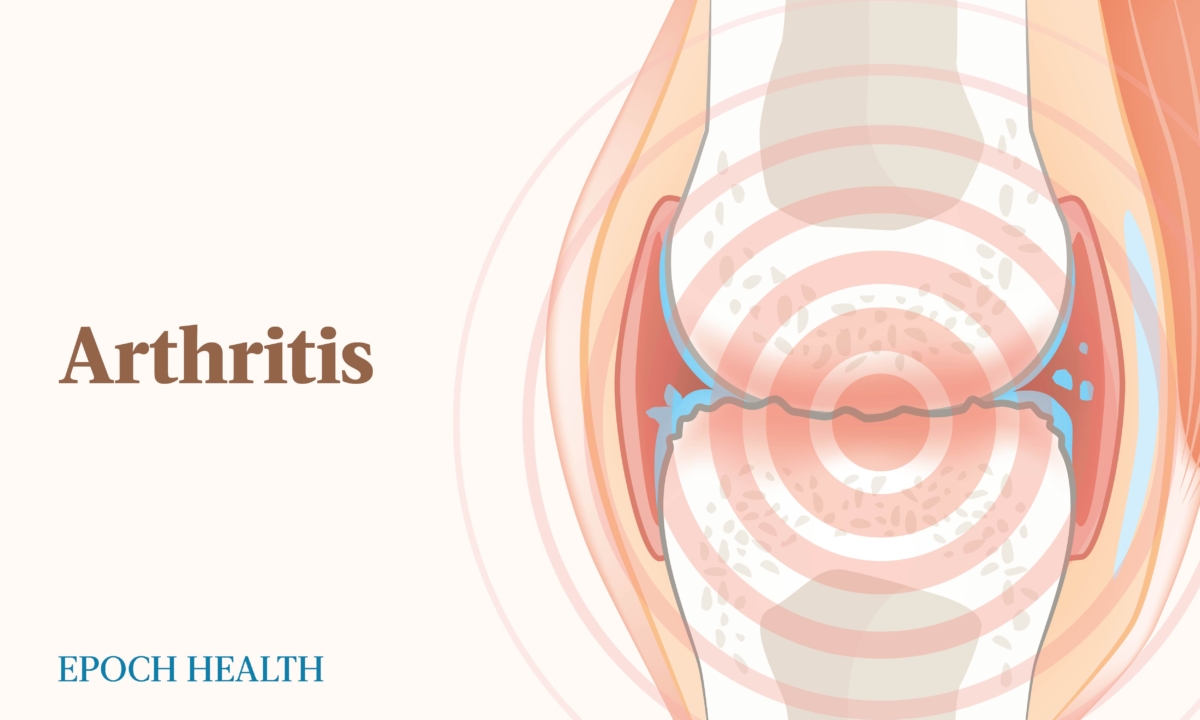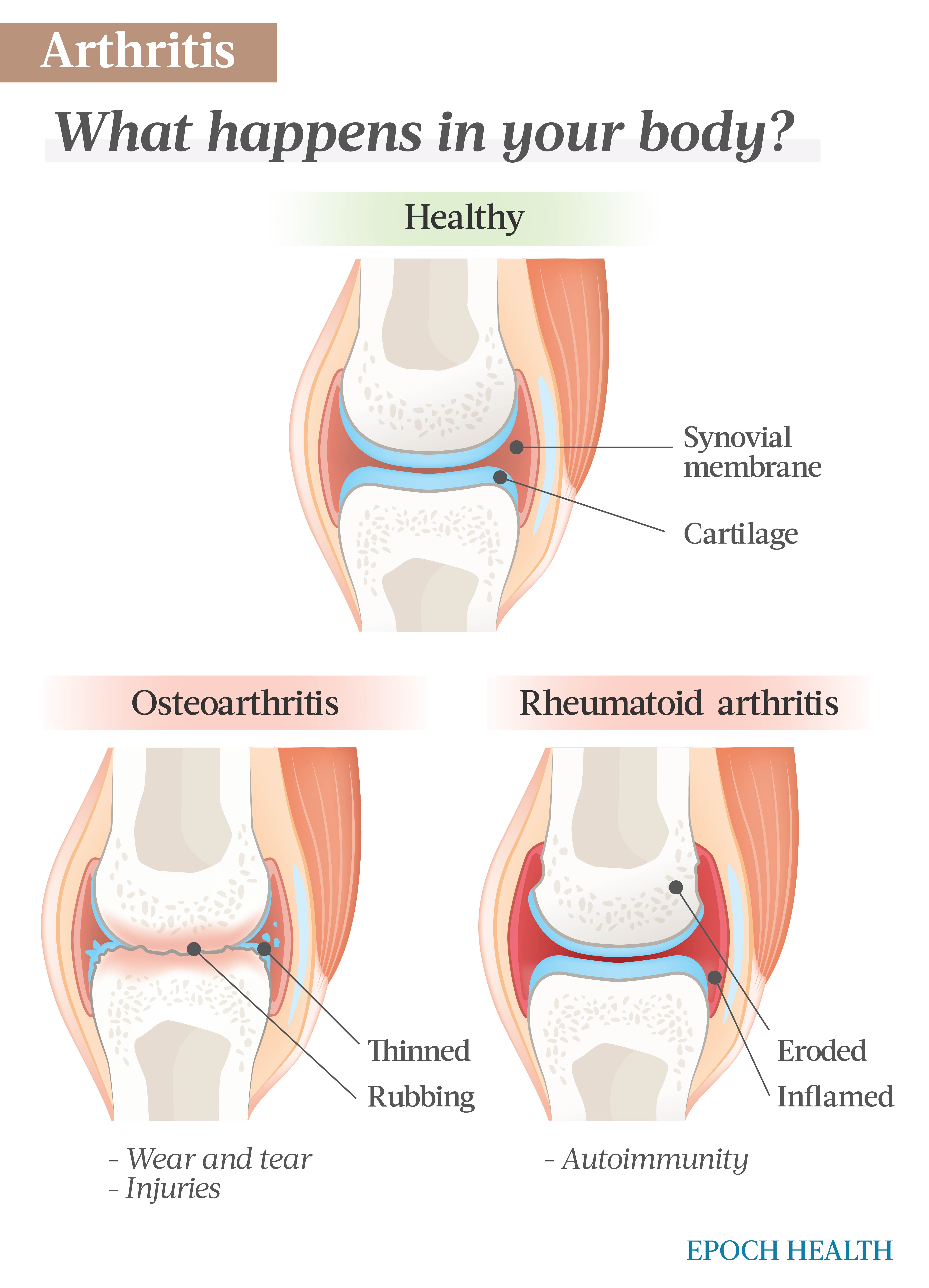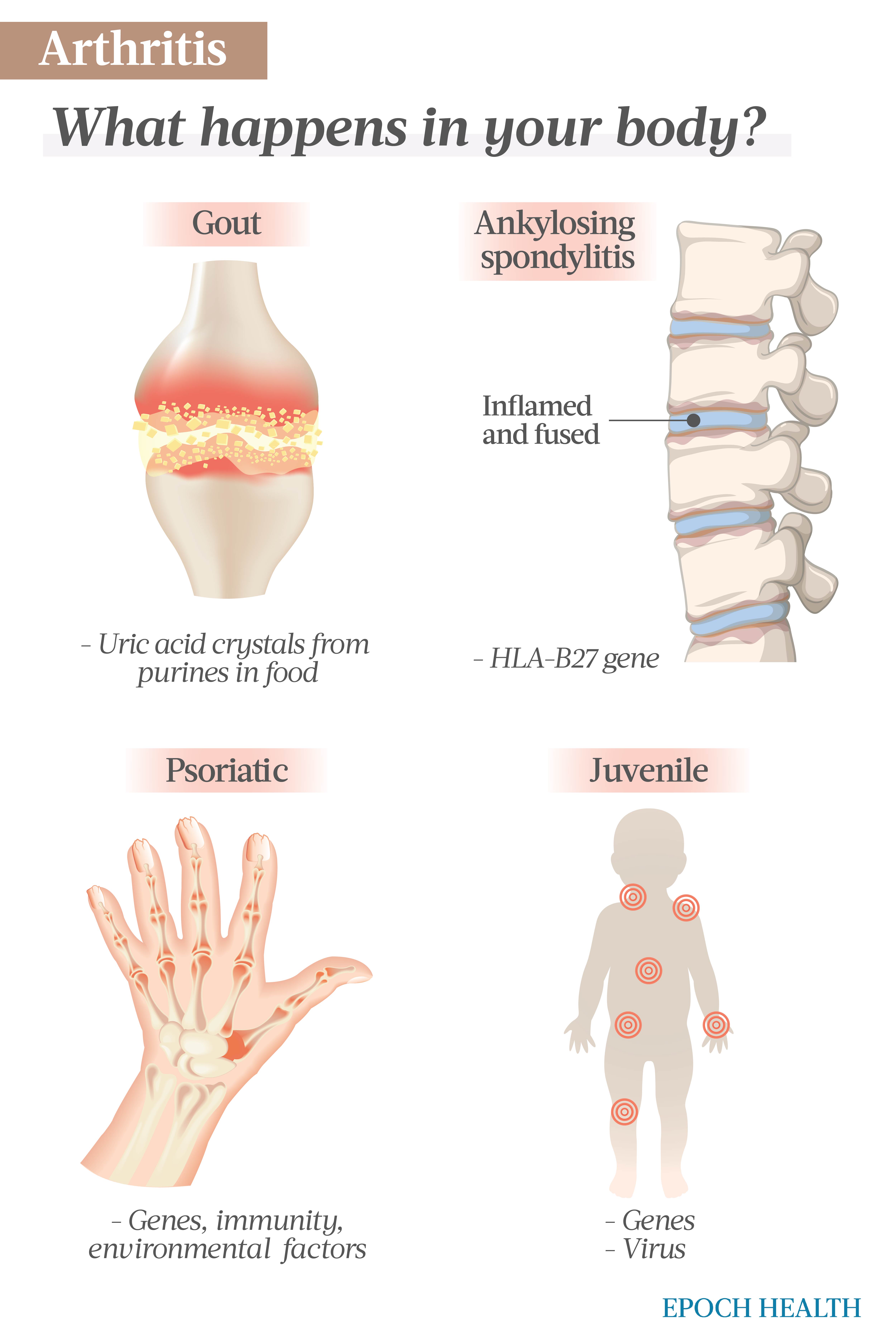


Arthritis is a joint disorder that is the most common cause of disability in the United States, with approximately 50 million adults and 300,000 children affected by it. It typically involves inflammation, swelling, and degeneration of one or more joints and causes pain when the joint moves.
Soft tissues cushion your joints and prevent bones from grinding on one another. Articular cartilage, a connective tissue, enables joints to move without pain or friction.
Some joints are kept lubricated by fluid padding called synovial membranes. Others are also supported by tendons (connecting muscle to bone) and ligaments (connecting bone to bone). Different types of arthritis affect different parts of the joints.
There are over 100 types of arthritic conditions, including the following:
Osteoarthritis is joint degeneration, a form of arthritis that results from stress on the joint that breaks down joint cartilage. It is the most common form of arthritis and typically affects the hands, hips, and knees.
With osteoarthritis, the joint changes, and these changes get worse with time. This form of arthritis can cause pain, swelling, and stiffness, resulting in reduced function and disability and affecting a person’s ability to perform daily tasks.
The second most common type of arthritis is rheumatoid arthritis, an autoimmune disease. With rheumatoid arthritis, the immune system attacks the synovial fluid within the joints. This attack on the joints results in joint inflammation, most often in the hands, knees, and ankles. Commonly, it involves the same joint on both sides of the body. In rare cases, rheumatoid arthritis can also cause problems with the eyes, heart, and lungs.
This type of arthritis causes the formation of uric acid crystals in the joints. It affects one joint at a time, causing inflammation and swelling. The most common joint affected is the big toe. This condition gets progressively worse.
Ankylosing spondylitis is also known as arthritis of the spine and usually occurs in the lower back. It may also cause inflammation in the knees, ankles, and hips. This spine arthritis can cause fusion of the vertebrae, leaving the spine rigid and inflexible. People with this type of arthritis may also develop an eye disease called uveitis, psoriasis, or inflammatory bowel disease.
Also known as juvenile idiopathic arthritis, this type affects children 16 years old or younger by attacking tissue around the joints. The most common form of juvenile arthritis is juvenile idiopathic arthritis, a chronic condition affecting about 300,000 children under 18. Unless they receive aggressive treatment, those diagnosed with juvenile arthritis will have persistant active arthritis 10 years after diagnosis.
Psoriatic arthritis develops in people with psoriasis, a condition that causes red and scaly skin, and causes inflammation and pain. On average, up to 30 percent of people with psoriasis will develop psoriatic arthritis. This type is similar to rheumatoid arthritis in its presentation of symptoms but tends to affect fewer joints.
Some symptoms are shared among all types of arthritis, while some are specific to certain types. Common arthritis symptoms are:
Rheumatoid arthritis shares these common symptoms with other types of arthritis, but other symptoms may be present, too. Additional symptoms of rheumatoid arthritis include:
Ankylosing spondylitis often causes stiffness and pain in the lower back that may come and go. During periods of rest, the pain usually worsens, such as in the middle of the night or after long periods of sitting.
A child having a morning limp may indicate juvenile arthritis. Children can experience flare-ups of symptoms that never go away, or many may never experience the symptoms again after the flare-up.
Psoriatic arthritis may also have typical symptoms of arthritis. This type of arthritis is often found in fingers and toes and may result in deformed joints. Symptoms of psoriasis may develop before or after the arthritis.
In general, arthritis forms in the following steps:
- Joint inflammation (including from overuse, immune response, and uric acid crystals).
- Joint damage.
- Joint stiffening.
- Joint growth is altered (abnormal overgrowth, erosion, etc.).
It has many potential causes depending on the type.
Osteoarthritis can be caused by wear and tear on the joints. The wear and tear break down the cartilage at the joints, causing pain, discomfort, and decreased range of motion.
An autoimmune condition, rheumatoid arthritis results from the body attacking itself, identifying parts of the joint as foreign to the body. The triggered immune response results in attacks on those parts of the joints.
The cause of gout is hyperuricemia, a condition involving high uric acid levels in the body. When you eat, purines naturally present in the body and in many foods break down. When there is too much uric acid, uric acid crystals build up in the body’s joints, fluids, and tissues, causing pain and inflammation. Hyperuricemia doesn’t always lead to gout.
The cause of ankylosing spondylitis is unknown, though researchers believe genetics and environment have roles to play. The HLA-B27 gene, in particular, is known to predispose a person to developing this form of arthritis, but having the gene does not guarantee one will develop it.
The exact cause of arthritis in children is unclear. However, while juvenile arthritis is not hereditary, scientists believe genetics are involved. Still, it is unusual for children in the same family to have juvenile arthritis. It’s possible an environmental factor, such as a virus, can cause this type of arthritis.
Researchers don’t know what causes psoriatic arthritis, but it is likely that a combination of genes, environmental factors, and individual immunity contribute to its development.
Factors that put you more at risk for arthritis are the following:
Diagnosis of arthritis begins with a physical exam. During the exam, the health care professional will ask about your symptoms, health history, and how the joint pain has affected your life. He or she will also assess your joints’ range of motion, pain, tenderness, and swelling.
Other than the health history and physical exam, your physician may order tests to confirm an arthritis diagnosis or determine the type of arthritis.
Imaging tests such as X-rays, ultrasounds, or MRIs can identify the following:
Blood tests do not generally diagnose arthritis. However, they may help identify the type of arthritis, such as rheumatoid arthritis, gout, and psoriatic arthritis.
Blood tests can help diagnose gout by detecting uric acid in the blood. Other tests that identify inflammation can diagnose rheumatoid arthritis. A health care provider can diagnose psoriatic arthritis with a blood test examining erythrocyte sedimentation rate (ESR), determining how quickly red blood cells accumulate at the bottom of a test tube. The faster and heavier they clump together, the more severe the inflammation.
Sometimes, genetic testing can help determine the type of arthritis you have, too.
Many complications are associated with arthritis, with several present in only some types of arthritis. Some of the complications of the discussed types are as follows:
Complications of rheumatoid arthritis include:
Complications of ankylosing spondylitis include:
Juvenile arthritis can negatively impact bone growth and development. Joints may grow unevenly, resulting in one leg or arm being longer or shorter than the other. Children may also develop eye inflammation, which can lead to cataracts, glaucoma, or blindness if untreated.
Complications of psoriatic arthritis include those from decreased exercise and inefficient use of iron by the body:
There is no cure for arthritis. Medications and other therapies may minimize the symptoms and complications of arthritis. In the worst cases, a health care professional may recommend surgery.
Medications commonly used to treat arthritis are nonsteroidal anti-inflammatory drugs (NSAID) such as ibuprofen and other anti-inflammatory drugs. Acetaminophen may also help with pain relief. Viscosupplementation is an injection that may be used to lubricate joints.
Other medications for specific types of arthritis include:
Discuss medications, over-the-counter or otherwise, and their side effects with your health care provider before taking any.
For severe cases, surgery may be necessary. Joint repair and replacement are two types of surgical options. If you have severe ankylosing spondylitis, one surgical option is laminectomy, which relieves pressure on nerves. You may also have surgery to straighten the spine or fix fractures. Other surgeries may include the replacement of hip, ankle, shoulder, and knee joints due to arthritic damage.
Besides medications and surgery, other therapies may address the symptoms or complications of arthritis. Such treatments include the following:
Mental health can affect how a person experiences the symptoms and complications of arthritis.
Anxiety and depression are the most common mental health conditions experienced by people who have arthritis. Mental health can both impact symptoms and be affected by them. Depression and anxiety put your body in an inflammatory state and can decrease a person’s pain threshold, while increased pain can increase depression and anxiety.
People with depression and anxiety are also less likely to follow their treatment plans, which can increase the chances of acquiring other health conditions.
Paying attention to the present moment is mindfulness. Mindfulness can help manage mental health symptoms due to arthritis, such as anxiety, depression, and stress. Research has also shown that mindfulness can also help with pain management.
Stress can increase flare-ups and arthritic symptoms. Managing stress requires learning how to reduce stressors, accepting what you cannot change, and overcoming the harmful effects of stress. Learning coping mechanisms like adjusting mindset can help manage stress, reducing flare-ups and symptoms.
While there is no cure for arthritis, several natural approaches can help manage it.
Many mind-body therapies and relaxation practices, such as yoga, tai chi, meditation, acupuncture, massage therapy, and deep breathing, help reduce pain and stress associated with arthritis.
One study found tai chi to have similar benefits as physical therapy for knee osteoarthritis. Another study found yoga may reduce arthritic symptoms in knees.
If knee arthritis is severe enough that it requires surgery, but the individual is unable to have the procedure, acupuncture may be an option. A meta-analysis showed that acupuncture can provide short-term pain relief for chronic knee pain due to osteoarthritis.
People with arthritis may also benefit from massage therapy. A review of seven randomized controlled trials with 352 participants found that massage may reduce pain and improve function.
Herbal and dietary supplements have shown promising results in minimizing the symptoms and complications of arthritis. However, data do not sufficiently support most of these claims, and further research is needed.
Supplements that may help with arthritis include:
The food you eat has a huge bearing on your overall health. Eating the right foods can also ease the burden of living with arthritis.
Eating a diet rich in whole foods and avoiding processed foods can help with inflammation and joint pain.
Certain foods can help manage the symptoms of arthritis:
Some claim avoiding nightshade plants like potatoes, eggplants, tomatoes, and peppers may reduce arthritic symptoms. However, there is not enough data available to support these claims.
While grass-fed meats and seafood contain numerous nutrients, people with gout may want to avoid them, as consuming them can increase uric acid levels. People with gout may need a low-purine diet to minimize the risk of gout flare-ups. Foods to avoid include:
You can do some things to lower your chances of developing arthritis or minimize your risks. Modifying the following behaviors can help prevent arthritis:
Including exercises in your daily activity can help minimize stiffness and ease joint movement. Moderate exercises and stretching can reduce joint pain and improve balance.
Aerobic exercise that increases your heart rate is also essential. Such activities can improve cardiac health and encourage weight loss, easing joint stress.
It is important to remember to limit exercises to those that do not threaten your joints. Some things to remember when you are exercising include:
Medically reviewed by Beverly Timerding, MD.


